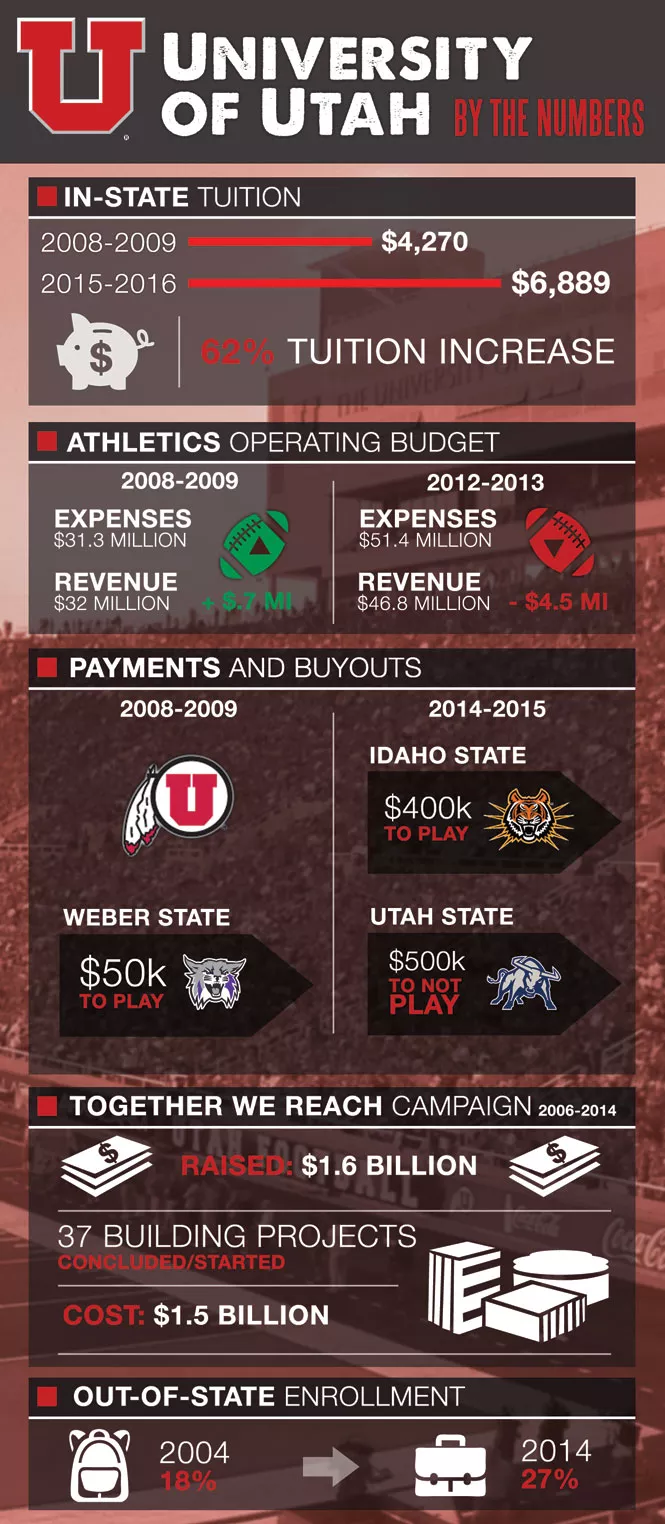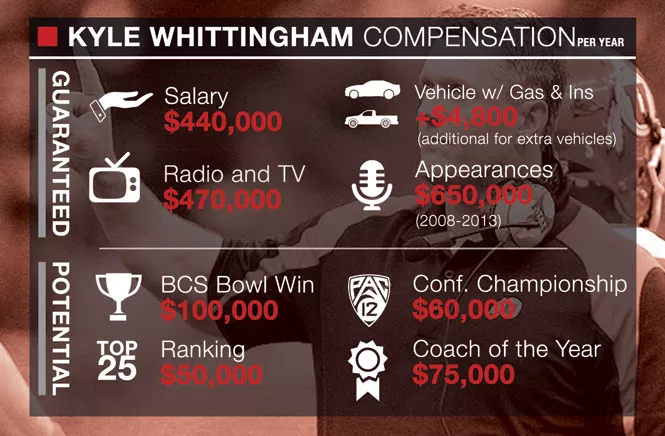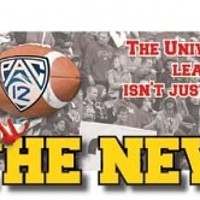A few years ago, the University of Michigan wouldn't pick up the phone when University of Utah Athletic Director Chris Hill would call. The Wolverines, which have the largest football stadium and one of the most storied college football programs in the land, wouldn't even return Hill's messages.
"There is absolutely zero possibility of Michigan coming to play at the University of Utah five years ago," Hill says. "Zero."
A lot has changed since then for Hill and the University of Utah. The school is now four years into its relationship with the Pac-12 Conference. And, next year, none other than the Michigan Wolverines are going to visit Rice-Eccles Stadium for a game of pigskin.
"I think there's a real halo effect by being in the Pac-12," says Fred C. Esplin, vice president of university relations. "If your peers are Stanford and USC and Cal and Washington and these folks, it makes a difference."
There is little question that the U's 2010 admittance into the Pac-12 has afforded it the opportunity to play more high-profile teams. The U now faces off against USC, UCLA, Stanford and Oregon instead of Wyoming, New Mexico, San Diego State and Air Force. Long-time rivalries against BYU and Utah State have also been jettisoned, at least temporarily. The decision not to play Utah State during the 2014 football season cost the U $500,000.
Pac-12 membership also brings with it the perception that, now that the school is part of a big-time club, it must somehow keep up with the other members of that club in what it offers to students, administrators and alumni, whether that's new buildings or more rigorous academic standards. Esplin says he refers to this as being "Pac-12 ready."
The easiest way to gauge this is through the size of the U's bank account. In 2006, the U unveiled a capital campaign called "Together We Reach." During the nine years of the campaign, which concluded this year, the U raised $1.65 billion. In 2008, 61,998 individuals contributed to the campaign. In 2014, 134,469 donors gave money.

Esplin says that from the moment the U became a Pac-12 member, giving shot through the roof.
"There's no question at all in my mind that joining the Pac-12 really helped that," Esplin says. "It is very, very clear that the pride the alumni feel, not just the fans, not just athletic fans, what the alumni feel for the university, was enhanced because of that."
University administrators say that simply by being associated with the likes of Stanford and UC Berkeley, the University of Utah has, and will continue to, become a more distinguished institution in all aspects.
Ruth Watkins, vice president of academic affairs, says the U has been able to recruit great academic talent in recent years "in all seriousness, because we're a Pac-12 school."
Watkins says the U, even when it was a member of the Mountain West Conference, was ahead of several of its peer institutions in categories like research. But in the ever-growing competitive world of academia, being a member of the Pac-12 can cast a tangible spell upon would-be faculty.
"It's very, very positive for the institution," she says. "What I can tell you is that it gets us into a little different dialogue and conversation among big players in the country."
The U's athletic teams now play big-time California teams USC, UCLA, Stanford and Berkeley on a regular basis, and often on national television. Herein lies the academic importance, perhaps, of being associated with a prominent athletic league: At three different student-recruiting events in California last year, Watkins says, she heard from many students that the U's Pac-12 membership was important to them.
Watkins says Pac-12 membership, at least partly, has also enabled the U's student body to diversify. School statistics show that in 2013, the percentage of freshman students from the United States who were minorities was 29 percent, up from 18 percent in 2008. Similar rises were seen in freshman from states other than Utah, with the number jumping to 25 percent in 2013 from 18 percent in 2008.
The campus landscape itself has seen the effects of the U's efforts to become more distinguished. During the Together We Reach campaign, 37 construction projects either commenced or were concluded on campus to the tune of $1.5 billion. A handful of these were new and improved athletic facilities, including a $30 million football center, $1.8 million strength and conditioning center and a $23 million basketball center.
Since entering the Pac-12, interest in athletics, especially football, has grown. In 2008, the football team generated $16.4 million in revenue, partly by selling $5.4 million in tickets and garnering $2.7 million in private contributions from donors. In the 2012-13 school year, it raked in $29.2 million in revenue, selling $9.9 million in tickets and receiving just under $6 million from donors.
Pac-12 membership hasn't yet fully translated into profits, however, as the athletic department's budget has also jumped sharply. In 2008, it spent $31.3 million on athletics, with revenues of $32 million. In the 2012-2013 school year—the most recent for which statistics exist—the department spent $51.4 million but brought in $46.8 million in revenue, resulting in a $4.5 million deficit.
But for its first two years in the conference, the U received just half the amount of the Pac-12's robust television contracts that long-time members of the Pac-12 receive. In 2013-2014, it raked in three-quarters of the total; this year, and going forward, it will receive the full allotment—roughly $18 million. If Utah had remained in the Mountain West Conference, it would be receiving around $4 million in television revenue.
Since college football players still don't get paid, the largest benefactor of this Pac-12 cash has been head football coach Kyle Whittingham, Utah's highest paid public employee. In 2008, Whittingham's base salary was $200,000, and he reaped $270,000 from money the school made on broadcasting and television contracts. When his contract was extended in 2011, Whittingham's base salary was jacked up to $440,000, with broadcasting money leaping to $470,000. Over the duration of his contract, Whittingham also gets $605,000 for speaking engagements and for participating in fundraising activities.
But the real dough flows when Whittingham's team plays well. When the Utes recently broke into the Associated Press' Top 25 poll, Whittingham got a $10,000 bonus. If the Utes finish the season ranked in a poll, he'll take home $50,000. If the Utes participate in a bowl playoff game, he receives $200,000. And if the Utes win one of these bowl games, the coach gets an additional $100,000. For a lowlier bowl, Whittingham gets two months' base salary, and for being named national coach of the year, as he was in 2008, he receives $75,000.

All of this talk about money brings the conversation right back to Michigan—or, rather, the teams that the U chose to play or not to play during the current football season.
Where the U once upon a time had to beg to play teams like Michigan, it now has the resources to pay lower-level teams large chunks of money to travel to Salt Lake City and see what it's like to get beaten by a Pac-12 team. This year, the U paid Idaho State $400,000 to fill its opening-game slot. In week No. 2, it paid Fresno State $300,000 to roll into town. The Utes can also pay teams they don't want to play anymore. This year, the Utes—in a buyout of a contract—paid the formidable Utah State Aggies half a million dollars to stay away from Salt Lake City.
Athletically, the U's first four years in the conference have been a roller coaster, replete with defeat and struggle. The entire athletic department has snagged only one conference championship, in women's gymnastics for the 2014 season. In its first three full seasons in the Pac-12, the Utes' football squad garnered records of 8-5, 5-7 and 5-7, but are off to a 4-1 run this season with Oct. 4's marquee victory over UCLA, then ranked No. 8.
For Hill, the lack of success thus far in terms of brass in the trophy room isn't nearly as important as the simple fact that the University of Utah is now in an elite club that he and other university administrators have no doubt will rub off on the U.
"The difference now is we have the opportunity to compete at the highest level—we jumped the Grand Canyon," Hill says. "We're not afraid of high expectations, and we now are in a position to have as a high of expectations as you can possibly have."
